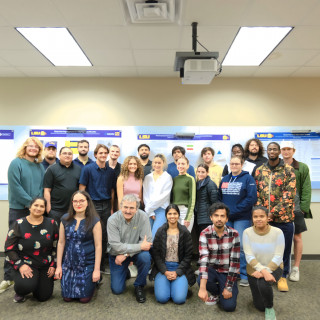Machine Learning: MATH 4020 Fall 2023

One team delved into "Appendicular Lean Mass: Insights through Regression Analysis." The collaborative effort aimed to construct a machine learning model predicting Appendicular Lean Mass (ALM) without the need for costly Dual Energy X-ray Absorptiometry (DXA) scans used in nutrition studies. Implementing linear and polynomial regression on a dataset which included 44 biomarkers gathered on 846 patients from the Pennington Biomedical Research Center, the team showcased that Principal Component Analysis (PCA) identified head circumference as a significant predictor of ALM and polynomial regression outperformed linear regression by 12 percent. The future objective of the collaboration is to build more efficient models to replace DXA scan and apply a semi-supervised learning algorithm based on p-Laplacian to integrate these models in future obesity, metabolism and nutrition studies.
In a separate presentation, another team addressed the project "Aquaponics: Deep Water Cultures Systems" showcasing the practical application of mathematical concepts. Their focus was on an image classification problem related to plants grown aquaponically in collaboration with the team at Pure Reason AI who are working in a deep-water culture system at LSU. The goal of the research project this semester was to classify plants into categories based on nutrient deficiencies. By training two neural networks and utilizing Python, the team successfully categorized plants in a dataset provided by Pure Reason AI into fully nutritious, potassium deficient, nitrogen deficient, and phosphorus deficient. Future plans for developing this project include additional methods in image classification and further developing neural networks to account for variables which challenge the categorification system including light, shadow and image noise as well as refining the system for user-friendly applications in aquaponic plant cultivation.
A different team took on the "Deep Learning Approach for Frog Egg Quantification." Initiated by Prof. Wolenski and the DeVision team, their project aimed to assist LSU's Aquatic Germplasm and Genetic Resources Center in counting frog eggs. After creating a Stardist-based model with 99.3% accuracy, the team this semester focused on minimizing the data required for replication of previous results. The group categorized egg ranges and reduced the total number of annotated images from 180 to about 20, showcasing significant progress. Future plans included extending the focus to classifying fertilized and unfertilized eggs, contributing to the practical application of mathematical tools in the field.
The final project presentation involved a separate team focusing on "Predicting Equities Markets using Monte Carlo Markov Chain Models and Probabilistic Neural Networks." This ambitious endeavor sought to develop two models predicting long-run returns of the S&P 500. The models used a Markov chain to determine regime switching in the United States Economic Policy Uncertainty Index (EPU), conditional probabilities of the S&P 500 moving up or down and a probabilistic neural network. Results demonstrated both models show average annual returns consistent with historical S&P 500 returns, highlighting the team's potential impact on understanding and predicting market trends through applied mathematics.
(Photo and Text: Jolie Cornay)